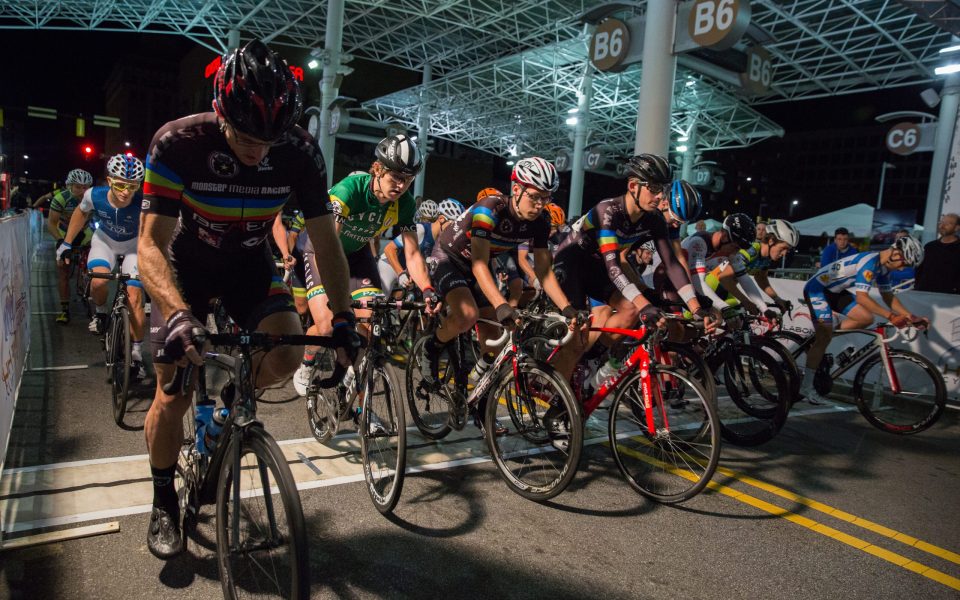It’s dark on the course. Lap after lap, the riders have jostled less because of it, being more cautious in obscurity. But a crowd of six turns the final corner together. Now it’s a sprint.
Downtown High Point has proved a fast course; they’ve averaged 27 miles per hour, and nearly an hour has gone by.
The physical anguish withdraws. It’s a mental game. This is awareness, reaction, savvy.
Now it’s just chess.
Have you been paying attention? Who’s a pawn, who’s a queen? What does each rider have left in him? Alder Martz has a hunch, he hopes. This year he’s spent five months racing in Europe and Asia. His team is international — registered in Slovenia, owned by an Australian and landing important Asian sponsors. But now the Charlotte native is home, supporting local racing.
With the finish line in sight, if Martz goes, if he dares the lead, how will the others act?
“I passed [the leader] with 100 meters to go,” Martz later described. “I thought I’d overtaken him too soon.”
The final race of the 2017 High Point Cycling Classic came to a furious end just before 10 p.m. on Sept. 9. The classic, which included several criterium races coupled with charity rides and other fundraising events, brought professional cycling back to High Point for the first time since the city hosted the USA Cycling Professional Criterium National Championships three years ago.
And in the weeks enveloping the classic’s races, art and history welcome the sport’s return.
A divide between professional and recreational endeavors accompanies all athletics. Sports descend from their heights of fandom, commodity and even propaganda to become tools for participants to transcend the challenges of life. At their best, they provide community, uniting an otherwise divided people onto the same side of an existential fight; they level the playing fields and steady the rules; they can defer us from life’s corruptions, presenting the chance to turn defeat into victory.
But nothing permits transcendance quite like the bicycle. It was a vehicle for human movement before it was involved in competition. Though we may cherish the objects of our favorite activities — an old tennis racquet, a beloved basketball, a grandfather’s baseball glove — nothing emancipates, nothing comes alive like the bicycle. Enabling real journeys, as some philosophers contend, it becomes an animated, vibrant thing.
And while the professionals flourished to the finish line out in the street, a more calm and contemplative examination of the bicycle enlivens the nearby walls of the High Point Theatre.
Within the grand theater in downtown High Point, Theatre Art Galleries displays visual art that usually embellishes the theater’s performances. But from Aug. 29 to Sept. 22, the exhibits complement the races outside.
The main gallery hosts The Bicycle: Art Meets Form — an invitational exhibit curated by Scott Raynor, an art professor at High Point University.
Through photography, watercolor, acrylics, linocut prints and mixed-media that incorporates old bicycle parts, many of the artists’ works represent the elations of freedom, motion and solitude so often tied to the experience of cycling. Julie Paisant’s photograph, “A Moment to Breathe,” as well as Victoria Alger’s watercolor, “Girl with the Red Sweater” — in which a young woman’s bike (with a red sweater in its basket) leans against a signpost in the foreground as she wades into the ocean in the distance — invoke the happiness and emancipation that bring so many to biking.
Yet some of the works incorporate the opposite effects — broken opportunities, or the sensations of being grounded and alone. Matthew Myers’ acrylic on wood panel, “Gravel to Grovel,” portrays a bicycle lying on its side on a dirt road that stretches endlessly into the distance. No one can be seen in the vast landscape, and stormclouds gather overhead.
Upstairs in the Theatre Art Galleries, another exhibit displays the historical rather than the personal. It features vintage Italian and American racing bikes from the collection of Chip Duckett, a founder of the High Point Cycling Classic who has collected and restored lightweight vintage bicycles for more than 35 years. The dozens of bicycles display the inventiveness and ingenuity of 20th Century designers, including a 1930s “Garibaldina” model from Alfredo Forcesi’s famous factory, Gloria.
Like the marriage of aesthetics and aerodynamics in a bicycle design, or the brushstroke that enriches a painting with depth and emotion, a cyclist must also devise the right lines and the right sequence.
In the Classic’s final race, 80 years after the gallery’s Garibaldina model first spun its wheels on Italian earth, six riders rushed for the finish line.
Alder Martz made the right move, outmaneuvering the others in speed and savvy to surge ahead at just the right instance. He won by a hairsbreadth, less than one second, as the six riders finished within four seconds of one another.
Cycling is back in High Point, and with its return come the decades of history and the fractions of seconds that allow the thrill of the sport to endure.
Join the First Amendment Society, a membership that goes directly to funding TCB‘s newsroom.
We believe that reporting can save the world.
The TCB First Amendment Society recognizes the vital role of a free, unfettered press with a bundling of local experiences designed to build community, and unique engagements with our newsroom that will help you understand, and shape, local journalism’s critical role in uplifting the people in our cities.
All revenue goes directly into the newsroom as reporters’ salaries and freelance commissions.


Leave a Reply